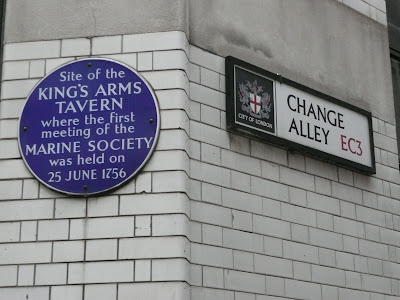Controversy often surrounds the announcement of the shortlist each summer, with many traditionalists unhappy that it includes work such as video art, sculpture, performance, installation art, and other modern media. Tracey Emin’s unmade bed and dirty underwear made the headlines in 1999. Where work on canvas is seen, it can be as surprising as Chris Ofili’s 1998 use of elephant dung attached to his canvases. Previous winners have included Anish Kapoor, Gilbert and George, Richard Long, Damien Hirst, Rachel Whiteread, Martin Creed, Grayson Perry, Richard Wright.
In 2010 the Prize was awarded to Susan Philipsz, the first time it has gone to an artist who specializes in aural work. She made an installation under three bridges in Glasgow in which she sang traditional Scottish songs.
By chance, there has been a series of installations of her work in the City of London this last three months called ‘Surround Me’. I went along during the New Year holiday to look and listen. It was commissioned by Artangel in six different places within the Square Mile, but only active at weekends, when the traffic noise recedes and many parts of the City become eerily quiet.
SURROUND ME embraces the vocal traditions of the City of London connecting themes of love and loss with those of fluidity, circulation and immersion; the flood of tears, the swelling tide and the ebb and flow of the river, to convey a poignant sense of absence and loss in the contemporary City of London.
At each location there is a small plaque with a description of the piece you will hear, and a short note about the source. So at Moorfields Highwalk you hear Philipsz singing the madrigal Weep, O Mine Eyes, written by John Bennet in 1599. It lasts just 1 minute 58 seconds, repeated every five minutes.

In open spaces or tiny enclosed alleyways small groups of people congregate: where the loudspeaker is visible, people are drawn to it, where it is hidden, and the sound bounces off adjacent buildings, they seem more comfortable to stand or wander and listen. The most arresting sight was the little dog I saw at three sites: at first appearing confused, later quite engaged.


The silver swan, who living had no note,
When death approached, unlocked her silent throat.
Leaning her breast upon the reedy shore,
Thus sang her first and last, and sang no more:
"Farewell, all joys! O Death, come close mine eyes!
"More geese than swans now live, more fools than wise."

Change Alley leads off Lombard Street, near the Bank of England. It is known as the precursor to the London Stock Exchange with the real trading conducted in the Alley’s coffee houses.
The idea of the trade in stocks and commodities in the City contrasts with the simple selling of oysters for the more uncomplicated pleasures of a well-prepared meal. The round is for three voices, one voice following the other in a layered cycle of singing. There is a short piece of video here (apologies for the quality).
Here I listened to Philipsz sing New Oysters, by Thomas Ravenscroft, 1609. This is played from two speakers set well apart from each other.

You can see and hear it here.
The final stop on my tour was right beside the Thames, directly under London Bridge, where Susan Philipsz sings Flow My Tears, written by John Dowland in 1600.
Flow, my tears, fall from your springs
Exiled forever, let me mourn;
Where night's black bird her sad infamy sings,
There let me live forlorn

The installations have now closed but you can read more about it in this Interview with Susan Philipsz and read about Twenty years of the Turner Prize here.
No comments:
Post a Comment